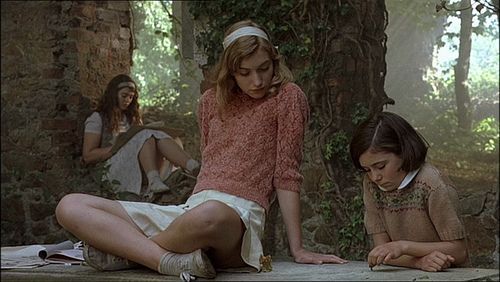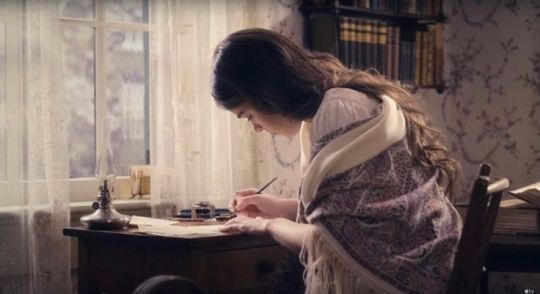Note
How to get into the mind of a character? Honestly this can be for your OWN character or a fictional character. I'm wanting to write for characters- headcanons and fanfictions- and I'm so afraid I'll write them so uncanny to how they actually are.
How to get into the mind of a character?
To get into the mind of a character, you have to understand that character, believe in that character, and even "live" the character's life. But we all know each individual is different, and we cannot live different lives. A normal person who grew up in peacetime cannot fully understand the hardships of a warrior, and a doctor cannot know the thoughts of a mafia boss.
So, how can writers create believable characters? How can they possibly offer a believable soldier, cop, detective, alcoholic, or any given character type if they themselves haven't lived as them? How can they possibly offer a believable character in a situation that they've never been in?
Here are some tips you can use to get into the minds of characters:
Tip 1: Observe real-life people
To create well-rounded characters, observe real people around you. Pay attention to their behaviors, mannerisms, speech patterns, and thought processes. Take note of how they express emotions, handle conflicts, and make decisions. Drawing from real-life observations can add depth and authenticity to your characters. You can also search for novels and movies with different themes, study how characters with different pasts, biographies, occupations, and personalities act, behave, gesture, and speak. The best way is to prepare a small notebook and a pen so you can carry it with you wherever you go.

Tip 2: Create a detailed character profile
Develop a detailed character profile that includes information such as their age, background, beliefs, values, goals, and fears. Consider their relationships with other characters and how these dynamics influence their thoughts and actions. Delve into the character's past and explore significant events that have shaped them. Consider their upbringing, traumas, successes, and failures. These can provide you with a roadmap for understanding the character's mindset.

Tip 3: Use internal monologues and journaling
Imagine the character's internal thoughts and dialogues with themselves. Consider what they might be thinking in different situations, their hopes, dreams, and fears. (And why do they dream of that? Why are they afraid of that thing? What in the past made them afraid? Always asking questions.) Writing internal monologues or journal entries from the character's perspective can help you delve into their mindset and gain insight into their unique voice.

Tip 4: Consider their external influences
Characters are influenced by their environment, culture, and society. Reflect on how external factors such as family, friends, societal norms, or even the story's setting impact their thoughts and behaviors. This will help you portray their worldview more accurately.

Tip 5: Study the source material
If you're writing about an existing character from a book, TV show, or movie, immerse yourself in the source material. Pay attention to their dialogue, actions, and interactions with other characters. Take note of their personality traits, motivations, and backstory. This will help you develop a strong foundation for understanding the character. For example, recently I suddenly became interested in Nightwing (do you know him? Nightwing from the Batman series!), and I wanted to write a few short stories about him. So I found all the comics and movies that featured Nightwing and watched them one by one. I don't take notes because I have a pretty good memory (especially for characters I like), but I still recommend taking notes on special things to note.

Tip 6: Practice free writing
Set aside time for free writing exercises where you write from the character's point of view. Allow your thoughts to flow without judgment or editing. Just write, write, and write. You can reread and make corrections after you're done. Remember to gather your posts in one place; otherwise, you'll lose or forget them (like me!).

Getting into the mind of a character is an ongoing process that requires continuous exploration and refinement. The more you invest in understanding your character's thoughts, feelings, and motivations, the more compelling and authentic your writing will become.
Additionally, you can read my articles on how to write an effective character here:
How to create a superbad villain
How to make a villain's appearance memorable
Basic questions for your character
Describing a villain's appearance in a natural way
Create an effectively past for character
Common character motivations
How to create a good main character
How to avoid the instance where a secondary character stands out more/ is more lovable?
Character flaws
Writing a good Anti-Hero
Character positive traits
How to write an elderly main character?
Protagonist who is a ballerina
How to write a believeable egotistical character

175 notes
·
View notes
Text
English neutral names
Taylor: a tailor or to cut (referring to the profession of tailoring).
Casey: a vigilant or "watchful.
Jordan: flowing down.
Avery: ruler of the elves or wise.
Morgan: born of the sea.
Riley: courageous or valiant.
Alex: defender of mankind (short form of Alexander or Alexandra).
Reese: enthusiasm.
Jamie: one who replaces.
Devon: the poet or bard.
Cameron: crooked nose or bent river.
Robin: bright fame, famous or just robin bird.
Sidney: wide island or wide meadow.
Shannon: small and wise.
Harper: harp player or minstrel.
Logan: little hollow.
Bailey: bailiff or steward.
Dylan: child of the sea.
Quinn: the fifth or counsel.
Skylar: the scholar.

#writeblr#writers#writer things#writers on tumblr#writersociety#on writing#writerscommunity#creative writing#writing#writblr#writings#writers and poets#write#writer#women writers#ao3 writer#author#writing stuff#writing advice#writing a novel#writing asks#writing a book#writing about writing#writing prompt#writing tips#writing community#writing inspiration#name ideas#character names#names
448 notes
·
View notes
Note
How did you start posting on Tumblr? And do you have any tips or advice for people wanting to start a blog too? You honestly have inspired me to try writing too! <3
There is only one sentence: do, and persevere. That's all what I do, so if you want to start a blog on Tumblr or anywhere, just do it.
14 notes
·
View notes
Note
How to get into the mind of a character? Honestly this can be for your OWN character or a fictional character. I'm wanting to write for characters- headcanons and fanfictions- and I'm so afraid I'll write them so uncanny to how they actually are.
How to get into the mind of a character?
To get into the mind of a character, you have to understand that character, believe in that character, and even "live" the character's life. But we all know each individual is different, and we cannot live different lives. A normal person who grew up in peacetime cannot fully understand the hardships of a warrior, and a doctor cannot know the thoughts of a mafia boss.
So, how can writers create believable characters? How can they possibly offer a believable soldier, cop, detective, alcoholic, or any given character type if they themselves haven't lived as them? How can they possibly offer a believable character in a situation that they've never been in?
Here are some tips you can use to get into the minds of characters:
Tip 1: Observe real-life people
To create well-rounded characters, observe real people around you. Pay attention to their behaviors, mannerisms, speech patterns, and thought processes. Take note of how they express emotions, handle conflicts, and make decisions. Drawing from real-life observations can add depth and authenticity to your characters. You can also search for novels and movies with different themes, study how characters with different pasts, biographies, occupations, and personalities act, behave, gesture, and speak. The best way is to prepare a small notebook and a pen so you can carry it with you wherever you go.

Tip 2: Create a detailed character profile
Develop a detailed character profile that includes information such as their age, background, beliefs, values, goals, and fears. Consider their relationships with other characters and how these dynamics influence their thoughts and actions. Delve into the character's past and explore significant events that have shaped them. Consider their upbringing, traumas, successes, and failures. These can provide you with a roadmap for understanding the character's mindset.

Tip 3: Use internal monologues and journaling
Imagine the character's internal thoughts and dialogues with themselves. Consider what they might be thinking in different situations, their hopes, dreams, and fears. (And why do they dream of that? Why are they afraid of that thing? What in the past made them afraid? Always asking questions.) Writing internal monologues or journal entries from the character's perspective can help you delve into their mindset and gain insight into their unique voice.

Tip 4: Consider their external influences
Characters are influenced by their environment, culture, and society. Reflect on how external factors such as family, friends, societal norms, or even the story's setting impact their thoughts and behaviors. This will help you portray their worldview more accurately.

Tip 5: Study the source material
If you're writing about an existing character from a book, TV show, or movie, immerse yourself in the source material. Pay attention to their dialogue, actions, and interactions with other characters. Take note of their personality traits, motivations, and backstory. This will help you develop a strong foundation for understanding the character. For example, recently I suddenly became interested in Nightwing (do you know him? Nightwing from the Batman series!), and I wanted to write a few short stories about him. So I found all the comics and movies that featured Nightwing and watched them one by one. I don't take notes because I have a pretty good memory (especially for characters I like), but I still recommend taking notes on special things to note.

Tip 6: Practice free writing
Set aside time for free writing exercises where you write from the character's point of view. Allow your thoughts to flow without judgment or editing. Just write, write, and write. You can reread and make corrections after you're done. Remember to gather your posts in one place; otherwise, you'll lose or forget them (like me!).

Getting into the mind of a character is an ongoing process that requires continuous exploration and refinement. The more you invest in understanding your character's thoughts, feelings, and motivations, the more compelling and authentic your writing will become.
Additionally, you can read my articles on how to write an effective character here:
How to create a superbad villain
How to make a villain's appearance memorable
Basic questions for your character
Describing a villain's appearance in a natural way
Create an effectively past for character
Common character motivations
How to create a good main character
How to avoid the instance where a secondary character stands out more/ is more lovable?
Character flaws
Writing a good Anti-Hero
Character positive traits
How to write an elderly main character?
Protagonist who is a ballerina
How to write a believeable egotistical character

#writerscommunity#writers#writersociety#writer things#writeblr#writers on tumblr#on writing#writing#creative writing#writblr#writings#writer#words#write#writers and poets#women writers#ao3 writer#amwriting#author#writers life#female writers#writing stuff#writer stuff#writing resources#writing requests#writing reference#writing rambles#writing romance#writing a book#writing community
175 notes
·
View notes
Note
Hello!! I've been reading your blog for quite some time now, and it got me wondering... How do you write so easily? I have been finding writing hard, or actually getting into writing in general rather difficult. How do you just... Write? Or get motivated to write? Any tips or advice is helpful!! Thanks <3

Since these two questions are quite similar, I will answer them together in this article.
To be honest, it's quite difficult to answer the question of why I can write so easily clearly. I started writing at a very young age - when I was 8 years old, I began writing my first stories on paper (before that, I would compose them in my head). So, I became accustomed to transforming ideas into words and connecting them into paragraphs. As a child, I had numerous peculiar ideas, but since I couldn't draw them, I chose to write. Gradually, writing became a habit and a hobby for me.
I believe the reason I can write easily is the result of many years of practice. Writing has become second nature to me, just like a skilled craftsman easily creates a craft without needing as much time and effort as a beginner.
Of course, there are also moments when I can't write a single word. During such times, I mostly choose to ignore it and engage in other activities (lol) because I don't want to force myself to write. After all, writing is simply my hobby, not my job.
If you want to be motivated to write, I believe the best approach is to let your imagination run wild. When you have an idea, motivation will naturally follow. Additionally, it is beneficial to read a lot of books and practice your writing skills. It doesn't have to be limited to meaningful stories; you can write paragraphs describing people, scenes, or everyday experiences. By doing so, when you have an idea, you won't struggle to translate the thoughts in your mind into sentences on paper.
I hope you find enthusiasm in writing. If you have any questions, please feel free to send them to me!

#creative writing#writer things#writers#writers on tumblr#writersociety#writerscommunity#writing#writeblr#on writing#writblr#writings#writer#write#writers and poets#women writers#ao3 writer#writing life#author#writing stuff#writer stuff#writers block#my wrtitng#creative wrting#free wrting#wrtiting#wrtieblr#writing a book#writing community#writing advice#writing inspiration
27 notes
·
View notes
Note
Juuuust curious, who is your um, crush, if you don't mind me asking.
Also, thanks for reading my previous ask!
Ermmm, I don't have crush... Or you mean my favorite own character?
1 note
·
View note
Note
Hey, sophia,
Can horror stories have a happy ending?
Can horror stories have a happy ending?
Your question makes me want to write an essay lol.
Can horror stories have a happy ending? This is a very controversial topic.
In my opinion, the answer is yes. There are various famous horror works with a relatively happy ending, such as The Amityville Horror, The Haunting of Hill House, The Shining, Scream, and The Exorcist. The protagonists escape more-or-less unscathed, but could you really call them happy?
Some horror manages to portray the next step for the survivors as one of growth and rebuilding, calling on the same inner strength that allowed them to survive the events of their story. In other cases, the defeat of a powerful evil becomes a source of hope, with the antagonist's downfall being savored. However, these endings often carry a mix of both joy and sorrow, as they are colored by the darkness and horrors the protagonists had to confront.
#writerscommunity#writer things#writersociety#creative writing#writeblr#writblr#on writing#writers#writing#writers on tumblr#writings#writer#write#writers and poets#women writers#writers block#writer stuff#ao3 writer#writers life#female writers#writing stuff#writing a book#writing community#writing inspiration#writing advice#writing tips#writing prompt#horror
29 notes
·
View notes
Note
I usually find myself using the same range of ages in my stories (young adults, teens), and just plotting a crime story, I realized how unrealistic it was to have almost every single character in early stages of adulthood, especially the team researching the case. Of course I have in mind a lack of experience in certain things for them and stuff but it's pretty hard for me to do older or much younger characters idk why 😭 what would u recommend? Is it somehow bad not to have a variety of ages or making it less realistic? It makes me feel like I'm doing a teen novel, sry for my english and uh ty <3
How to include a broader spectrum of ages in stories
Well, in fact, it's not necessarily bad to focus on a specific age range in your stories, as long as it serves the narrative and the themes you want to explore. If you find it difficult to write for a wide range of ages, you can certainly focus on teenagers. A story about young detectives can also be engaging and exciting, right? But if you want to incorporate a variety of ages to add depth and richness to your story, here are a few suggestions to help you:
Tip 1: Develop characters
Create well-rounded characters of different ages, each with their own distinct personalities, perspectives, and life experiences. Develop their backstories, motivations, and goals in a way that reflects the impact of their age on their thoughts and actions.
Then, explore how age can influence characters' motivations, goals, and challenges. Older characters may bring wisdom, life experiences, and a different perspective, while younger characters may have a sense of idealism, curiosity, and growth potential. By considering age-related motivations, you can create more dynamic and believable characters.

Tip 2: Build relationships for characters
At different ages, people develop various types of relationships. For example, a 16-year-old girl may have relationships with peers, teachers, and family members, while an adult man may have relationships with family, coworkers, and friends in social settings.
Relationships between older mentors and younger proteges, or clashes between generations, can add depth and conflict to your story. These interactions can also provide opportunities for growth and learning for your characters.

Tip 3: Pay attention to characters' dialogue and language
The vocabulary, tone, and communication styles of characters from different age groups are different. Younger characters may use contemporary slang or have a more informal way of speaking, while older characters may have a more formal or seasoned approach. You can observe closely how the elders around you communicate and make notes in a notebook.

Tip 4: Research
If you find it challenging to write characters of different ages, consider conducting research or seeking firsthand experiences from people of those age groups. As mentioned above, you can make a small notebook to record the words, actions and behaviors of people around you in certain situations. Reality is always a great source of information if you know how to take advantage of it.

Tip 5: Beta and feedback
You can share your work with beta readers or writing groups that include individuals from various age groups. Their feedback can offer valuable insights and help you refine the portrayal of different age groups in your story.

Remember, storytelling is an art, and there are no set rules. Ultimately, it's about finding a balance that aligns with your creative vision while ensuring your story resonates with a diverse audience. Embracing a variety of ages can add depth and realism to your stories, expanding the scope of your narratives and making them more relatable to readers of different backgrounds and experiences.

#writer things#writerscommunity#writers#writeblr#writers on tumblr#on writing#writersociety#writing#writblr#creative writing#writings#writer#write#writers and poets#writing stuff#my wrtitng#creative wrting#wrtv#wrtblr#free wrting#writing a book#writing community#writing advice#writing tips#writer stuff#writing inspiration#writing prompt#writing resources#writing requests#writing reference
40 notes
·
View notes
Note
Have you read the webtoon bloodbath bakery by stainedge yet?
Sorry, it's not my type.
0 notes
Text
Common misfortunes for characters
Death of a loved one: This can be a profound and devastating experience for a character, leading to grief, guilt, and a sense of loss. It can also serve as a catalyst for character development and exploration of themes such as mortality, coping with loss, and the fragility of life.
Serious illness or injury: Physical or mental health challenges can test a character's resilience and force them to confront their limitations. It can also provide opportunities for exploring themes of perseverance, the importance of support systems, and the fragility of the human body.
Loss of a job or financial ruin: Financial struggles can lead to desperation, uncertainty, and a loss of identity for a character. It can also present opportunities for growth, reinvention, and exploring themes of resilience, resourcefulness, and the true value of material possessions.
Betrayal by a trusted friend or ally: Betrayal can shatter trust and lead to feelings of anger, betrayal, and a loss of faith in others. It can create complex moral dilemmas for the character and explore themes of loyalty, forgiveness, and the dark side of human nature.
Imprisonment or wrongful accusation: Being imprisoned or falsely accused can lead to feelings of powerlessness, injustice, and a struggle for redemption. It provides opportunities for exploring themes of justice, personal agency, and the lengths one will go to prove their innocence.
Natural disasters: Natural disasters can be catastrophic events that disrupt lives, challenge survival instincts, and test a character's resilience. They can explore themes of human vulnerability, the power of nature, and the strength of community in times of crisis.
War or conflict: War and conflict can have profound impacts on characters, leading to physical and emotional trauma, loss of loved ones, and moral dilemmas. They provide opportunities for exploring themes of heroism, sacrifice, the futility of violence, and the long-lasting effects of war.
Addiction or substance abuse: Characters grappling with addiction or substance abuse can experience a downward spiral, strained relationships, and a loss of control. It allows for exploration of themes such as self-destructive behavior, the road to recovery, and the impact of addiction on oneself and others.
Mental health issues: Characters dealing with mental health issues like depression or anxiety can face internal struggles, isolation, and difficulties in functioning. It provides an opportunity to delve into themes of stigma, self-discovery, and the importance of mental health support.
Loss of a child or miscarriage: The loss of a child or experiencing a miscarriage can be emotionally devastating for characters, leading to grief, guilt, and questioning of one's purpose or identity. It allows for exploration of themes of parental love, coping with loss, and the complexities of grief.
Failed relationships or divorce: Characters going through failed relationships or divorce can experience heartbreak, loneliness, and a sense of failure. It presents an opportunity to explore themes of love, forgiveness, personal growth, and the complexities of human relationships.
Alienation or social isolation: Characters who feel alienated or socially isolated can grapple with feelings of loneliness, rejection, and a sense of not belonging. It allows for exploration of themes of identity, acceptance, and the importance of human connection.
Identity theft or fraud: Characters who fall victim to identity theft or fraud can face financial ruin, loss of reputation, and a struggle to reclaim their identity. It provides opportunities to delve into themes of trust, deception, and the lengths one goes to protect their identity.
Accidental injury or disability: Characters experiencing accidental injury or acquiring a disability can face physical and emotional challenges, adjusting to a new way of life, and overcoming societal barriers. It allows for exploration of themes such as resilience, self-acceptance, and the meaning of true strength.
Loss of a treasured possession or heirloom: Losing a treasured possession or heirloom can evoke feelings of loss, nostalgia, and a connection to the past. It provides an opportunity to explore themes of materialism, attachment, and the value of intangible memories.
Being stranded or lost in a remote or dangerous location: Characters finding themselves stranded or lost in a remote or dangerous location can face survival challenges, fear, and the need to rely on their instincts. It allows for exploration of themes of resilience, self-discovery, and the inherent strength of the human spirit.
Struggling with poverty or homelessness: Characters experiencing poverty or homelessness can encounter hardships, discrimination, and a constant struggle for basic needs. It provides an opportunity to explore themes of social inequality, resilience, and the power of compassion and empathy.
Encounter with a dangerous or malicious antagonist: Characters facing a dangerous or malicious antagonist can be subjected to physical and psychological harm, manipulation, and a fight for their lives. It allows for exploration of themes of good versus evil, moral choices, and the strength of the human spirit in the face of adversity.
Political or social persecution: Characters experiencing political or social persecution can face oppression, injustice, and the fight for their rights and freedom. It provides an opportunity to explore themes of social change, courage, and the power of collective action.
Being framed for a crime they didn't commit: Characters who are framed for a crime they didn't commit can face wrongful accusation, a loss of trust, and the pursuit of justice. It allows for exploration of themes of innocence, perseverance, and the search for truth.
These misfortunes can be used individually or combined to create layered and complex narratives where characters face adversity, overcome challenges, and ultimately find strength and growth through their experiences. Remember to balance the misfortunes with moments of resilience, hope, and eventual triumph to create a compelling narrative.
If you want to read more posts about writing, please click here and give me a follow!

3K notes
·
View notes
Text
Common character archetypes in literature
Character archetypes are universal patterns of behavior, personality traits, and motivations that are commonly found in literature, mythology, and other forms of storytelling. They are often used as a shorthand to help readers quickly understand and relate to a character's role and purpose in the story.
Here are some common character archetypes:
The Hero: The hero is a brave and noble character who goes on a quest or journey to achieve a goal or overcome a challenge. Examples of heroes include Odysseus in Homer's "The Odyssey" and Frodo in J.R.R. Tolkien's "The Lord of the Rings."
The Villain: The villain is an evil character who opposes the hero and tries to prevent them from achieving their goal. Examples of villains include Darth Vader in "Star Wars" and Iago in Shakespeare's "Othello."
The Mentor: The mentor is a knowledgeable and seasoned figure who directs and encourages the protagonist throughout their adventure. Examples of mentors include Gandalf in "The Lord of the Rings" and Obi-Wan Kenobi in "Star Wars."
The Trickster: The trickster is a mischievous character who uses their wit and cunning to achieve their goals. Examples of tricksters include Loki in Norse mythology and Hermes in Greek mythology.
The Damsel in Distress: The damsel in distress is a female character who requires saving from a hero. Examples of damsels in distress include Princess Peach in the Mario video game series and Sleeping Beauty in the fairy tale of the same name.
The Wise Old Man/ Woman: The wise old man or woman is commonly portrayed as having immense wisdom and expertise, and often acts as a mentor or guide to the protagonist. Examples of wise old men and women include Dumbledore in the Harry Potter series and the Oracle in Greek mythology. Such archetypes have been frequently employed in literature over time to communicate universal themes and concepts about human existence.
The Innocent: The innocent is a pure and uncorrupted character who often serves as a symbol of hope and goodness. Examples of innocents include Dorothy in "The Wizard of Oz" and Boo Radley in "To Kill a Mockingbird."
The Outcast: The outcast is a character who is rejected by society and often feels a sense of alienation or isolation. Examples of outcasts include Frankenstein's monster in Mary Shelley's "Frankenstein" and Hester Prynne in Nathaniel Hawthorne's "The Scarlet Letter."
The Temptress: The temptress is a seductive female character who lures men into danger or temptation. Examples of temptresses include Circe in Greek mythology and the character of Delilah in the Bible.
The Scapegoat: The scapegoat is a character who is blamed for the problems or issues of others. Examples of scapegoats include Tom Robinson in "To Kill a Mockingbird" and Piggy in "Lord of the Flies."
The Rebel: The rebel is a character who challenges authority and often advocates for change. Examples of rebels include Winston Smith in George Orwell's "1984" and Holden Caulfield in J.D. Salinger's "The Catcher in the Rye."
The Everyman: The everyman is a relatable character who represents the average person and often serves as the protagonist in a story. Examples of everymen include Bilbo Baggins in "The Hobbit" and Winston Smith in "1984."
The Wise Fool: The wise fool is often portrayed as someone who appears to be simple-minded, foolish, or even insane, but who possesses insights and wisdom that are not immediately apparent to others. Examples of the wise fools include the protagonist in "Diary of a Madman" and Yorick in "Tristram Shandy".
The preceding list outlines the typical character archetypes found in literature. Can you determine which archetype best fits your characters?
If you want to read more about The Wise Fool archetype, click here: The Wise Fool - Who is that?

711 notes
·
View notes
Text
Poison list
While it's important to approach writing with creativity and imagination, it's crucial to prioritize responsible and ethical storytelling. That being said, if you're looking for information on poisons for the purpose of writing fiction, it's essential to handle the subject matter with care and accuracy. Here is a list of some common poisons that you can use in your stories:
Hemlock: Hemlock is a highly poisonous plant that has been used as a poison in various works of literature. It can cause paralysis and respiratory failure.
Arsenic: Arsenic is a toxic element that has been historically used as a poison. It can be lethal in high doses and can cause symptoms such as vomiting, abdominal pain, and organ failure.
Cyanide: Cyanide is a fast-acting poison that affects the body's ability to use oxygen. It can cause rapid loss of consciousness and cardiac arrest.
Nightshade: Nightshade plants, such as Belladonna or Deadly Nightshade, contain toxic compounds that can cause hallucinations, respiratory distress, blurred vision, dizziness, an increased heart rate, and even death when ingested.
Ricin: Ricin is a potent poison derived from the castor bean plant. It can cause organ failure and has been used as a plot device in various fictional works.
Strychnine: Strychnine is a highly toxic alkaloid that affects the nervous system, leading to muscle spasms, convulsions, and respiratory failure.
Snake Venom: Various snake venoms can be used in fiction as deadly poisons. Different snake species have different types of venom, each with its own effects on the body.
Digitalis: Digitalis, derived from the foxglove plant, contains cardiac glycosides. It has been historically used to treat heart conditions, but in high doses, it can be toxic. Overdosing on digitalis can cause irregular heart rhythms, nausea, vomiting, and visual disturbances.
Lead: Lead poisoning, often resulting from the ingestion or inhalation of lead-based substances, has been a concern throughout history. Lead is a heavy metal that can affect the nervous system, leading to symptoms such as abdominal pain, cognitive impairment, anemia, and developmental issues, particularly in children.
Mercury: Mercury is a toxic heavy metal that has been used in various forms throughout history. Ingesting or inhaling mercury vapors can lead to mercury poisoning, causing symptoms like neurological impairment, kidney damage, respiratory issues, and gastrointestinal problems.
Aconite: Also known as Wolfsbane or Monkshood, aconite is a highly toxic plant. Its roots and leaves contain aconitine alkaloids, which can affect the heart and nervous system. Ingesting aconite can lead to symptoms like numbness, tingling, paralysis, cardiac arrhythmias, and respiratory failure.
Thallium: Thallium is a toxic heavy metal that can cause severe poisoning. It has been used as a poison due to its tastelessness and ability to mimic other substances. Thallium poisoning can lead to symptoms like hair loss, neurological issues, gastrointestinal disturbances, and damage to the kidneys and liver.
When incorporating poisons into your writing, it is essential to research and accurately portray the effects and symptoms associated with them. Additionally, be mindful of the potential impact your writing may have on readers and the importance of providing appropriate context and warnings if necessary.
If you want to read more posts about writing, please click here and give me a follow!

#creative writing#writing#writerscommunity#writersociety#writers#writers on tumblr#writblr#on writing#writer#words#write#writing stuff#writing tools#writing prompt#writers and poets#writing community#writings#writing tips#writing advice#writing inspiration#poison type#literature#writeblr#belladonna#writer things
19K notes
·
View notes
Note
I think you are the only one I have told, but I have a question.
Kinda to do with stories. Kinda not.
I kinda sorta have a crush on my own character, and I only notised, because after a couple of weeks I checked my drawings and notes, and they were mainly on one character. I though maybe it was one of my phases where I interrogate on certain characters while developing them, but then my sister commented that she could hear my heartbeat, (we were sat next to each other) and pointed out my face was flushed. I then, to my embarrassment realised why.
Does this make me crazy or something? Shouldn't my heart and brain Dave this feeling for a real person?
I don't know if this has anything to do with psychology or science, but for me, it's perfectly normal. Who you like and what you like is your right, even if it deviates from the norm. No one has the right to judge that unless your preferences involve actions that harm others.
(By the way, I also have a character that I'm really fond of. I'm even crazy about him to the point that everyone around me knows I like a bogus character haha.)
1 note
·
View note
Note
Hello dear,
I recently found your page. Thank you so much for inspiring us! Glad I found ur account.
I thought of asking you....
I started to write 5 years ago. From last year may I started to put my work online.
Now, I feel like emotions arent flowing like they used to flow( I m experiencing burnout , seeking help as well)
Writing is only thing I have which helps me to understand and feel. I feel like I have to feel first to write about it.
Can you give me any advice how I can slowly get back to writing again. I started to feel like me and words now lives on parallel lines waiting for reunion.
I really want to share my work with lovely people, I dont care much about followers as long it reaches to right people who needs it. I want to explore human emotions to extent where we all shine through our scars.
Will wait for respone. Lots of love.
Take care.
First, thank you for your compliments. I'm glad to have met lovely followers like you too.
I understand your situation very well right now because I have also gone through the same thing. Don't worry, this is an inevitable process in writing that I believe every writer or author has encountered at least once.
In fact, there is no way I can help you, as each person is different. But, I can give you few ways I did.
Firstly, you can take a break and engage in activities that recharge you. This could include reading, spending time in nature, practicing self-care, or pursuing other hobbies that bring you joy. The more comfortable you are, the easier it will be to write. Don't put too much pressure on yourself, it will only make you more stuck.
Secondly, seek your inspiration by engage with different forms of art, such as reading books, watching movies, listening to music, or visiting exhibitions. You can also start a person journal where you can freely express your thoughts, emotions, experiences, and save new ideas.
You should start from small and set realistic writing goals for yourself. Instead of pressuring yourself to write a complete story or novel, focus on smaller writing exercises or prompts. Gradually increase the time and effort you dedicate to writing as you regain your rhythm.
Remember, the process of rediscovering your writing passion may take time. So be patient with yourself and allow yourself the space to heal and rejuvenate. Writing should be a joyful and fulfilling experience, so focus on reconnecting with your own emotions and finding your unique voice.
#writeblr#writer things#writers#writersociety#writers on tumblr#on writing#writerscommunity#writing#writblr#creative writing#writing adventures#writing advice#advice#write#writings#writers and poets
21 notes
·
View notes
Note
Miss Sophia, I have a question. Um, well first of all...
I actually like slice of life, fantasy, romance, horror, sci-fi.
But my question is... Ahem. How do you make romance scenes non cringy?
Becsaiw sometimes when I'm writing them, I cringe, and feel weird. Others, my my heart flutters.
How to make romantic scenes not cringe?
Well, honestly, for me, this question is so hard to answer... As my strength is romance, I can't give you any advice based on my experience. What I do when writing romantic scenes is simply… imagine and write. So, I searched the internet, read some articles and learned a few things. Hope it will help you.
Tip 1: Develop realistic and relatable characters

Ensure that your characters are well-rounded and have depth. Give them distinct personalities, flaws, and motivations that readers can connect with. This will make the romantic interactions more believable and engaging.
Tip 2: Show, don't tell

Instead of explicitly stating how characters feel, demonstrate their emotions through their actions, dialogue, and body language. How do they treat each other? How do they talk to each other? When one person is sick, what will the other person do? Are they shy or bold when meeting the person they love? The more details you tell, the more genuine the feelings between them will be.
Tip 3: Build emotional tension

Establish a strong foundation of emotional connection and chemistry between the characters. Develop their relationship gradually and create moments of anticipation and longing. This will make the romantic scenes more captivating and less cringe-worthy.
Tip 4: Prioritize consent and respect

Ensure that the romantic interactions include clear communication, mutual respect, and consent. Avoid any scenes that may promote unhealthy dynamics or non-consensual actions, as they can easily become cringe-worthy or uncomfortable for readers.
Tip 5: Use subtlety and restraint

Sometimes, less is more. Avoid over-the-top gestures or exaggerated romantic dialogue that can feel forced or insincere. Instead, focus on small, genuine, and meaningful moments that allow readers to connect with the emotions being portrayed.
Tip 6: Balance romance with other elements

Incorporate other elements such as humor, conflict, or character development alongside the romantic scenes. This will add depth and prevent the story from becoming overly focused on romance, which can sometimes lead to cringe-worthy moments.
Tip 7: Read romance novels

You cannot write a beautiful love story without reading any romance novels, unless you write it based on your own story. You can read famous works like Pride and Prejudice, Jane Eyre, Red, White & Royal Blue, or anything else that interests you, and learn how the characters interact with each other. This is the best way.
That's all. Good luck!

#writers#writer things#writerscommunity#writersociety#on writing#writblr#writers on tumblr#creative writing#writing#writeblr#write#writings#writer#words#world#writers and poets#writing stuff#writing a book#writing inspiration#writing tips#writing community#writing advice#writer stuff#writing prompt#my wrtitng#creative wrting#wrtblr#free wrting#writing resources#writing reference
72 notes
·
View notes
Note
Oh, also, I may be late,but, happy birthday! I hope your day went well.😊
Awwwww thank you very much! Thank you for supporting me! I will answer your question about writing advice as soon as possible. Have a nice day. <333
3 notes
·
View notes
Note
Hello, my name is lyla, and I have followed some of your writing tips and they have worked!
However. I had never checked your blog before.
I have two questions. Actually three.
Does being a feminist mean you hate men?
As a feminist, can you still love men?
What is a heterosexual?
(Apologies if I am accidentally rude, having autism and adhd may contribute to that.)
anyway, have a good day.😊❤
Hello lyla.
First, thank you for your follow. I'm glad my tips can help you.
Secondly, regarding your questions, well, I never thought that one day I would receive questions like these. I don't mean anything negative; it's just that your questions have surprised me quite a bit.
Does being a feminist mean you hate men? I believe there may be some misunderstandings about feminism. Personally, I don't harbor any hatred towards men; I strive to treat all individuals and genders equally. Feminism that harbors hatred towards men is not true feminism; it is toxic feminism. It's important to note that toxic feminism differs from true feminism.
As a feminist, can you still love men? Of course, yes. Why not? Being a feminist doesn't mean I can't appreciate men. Just like supporting a certain politician doesn't imply love for that person, right? Feminism is simply a socio-political ideology, not a sexual orientation.
What is a heterosexual? Heterosexual is sexually or romantically attracted to men if you are a woman, and women if you are a man. To put it simply, it's straight.
I hope the above has partially answered your questions. If you have any further questions, please feel free to send them to me.
22 notes
·
View notes